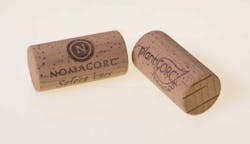The nature of global manufacturing is heartless—you’ve got to adapt, integrate new automation strategies and rely on management expertise to beat your competitors. Nomacorc executives saw the writing on the wall, and knew the company would have to adapt to stay competitive. An upgrade of its manufacturing execution system (MES) helped better connect its production of synthetic wine closures to the enterprise and improve operator performance.
The global manufacturer produces three different types of synthetic closures for bottles and can produce up to 7 million corks per day, including a plant-based closure. That kind of production may sound prodigious, but each year wine drinkers consume 30 billion bottles of wine and high-end vintners want assurances that trichloroanisole (TCA) doesn’t occur. TCA, also known as cork taint, can ruin a wine’s aroma and flavor while going undetected by wine producers. Prior to the introduction of synthetic corks, an estimated 10-15 percent of all wines were contaminated with cork taint.
With increasing demand for its closures, Nomacorc wanted a better enterprise and production platform that would include a repository for process, alarm and overall equipment effectiveness (OEE) data; a common graphics format for all HMI systems with support for multiple languages (since the company has plants in different countries); a common underlying framework to support communication to all PLCs and HMIs, allowing for these systems to send data to business systems; and new alarming communications.
Automated Control Concepts, a certified system integrator for Schneider Electric’s Wonderware, has installed the first platform upgrade, and a second Nomacorc plant is waiting for upgrade approval.
“Nomacorc wanted more than monitoring,” says Chris Monchinski, director of MES at Automated Control Concepts. “They wanted to modify operator behavior and drive continuous improvement, and needed data to maintain data accuracy and uptime. But they also wanted the system to be modular to simplify maintenance.”
Key monitoring challenges included cork counting (good or bad), raw material usage, order change transactions, and interfacing between equipment and the OPC server.
Legacy restraints
Wonderware’s ArchestrA SCADA platform executes the batch control for the synthetic and plant-based corks, along with InTouch HMI Software throughout the plant. Before the switch away from the legacy InTouch application, Nomacorc couldn’t add ArchestrA’s modern HMI graphics, hampering optimal operational performance.
The control process includes management of plastic pellets, blending, extrusion, cooling, heating, quality control, and cutting to length. “The blend of polymers and the extrusion process control must be maintained continuously to ensure consistent high quality,” Monchinski says. At the end, printers apply customization to the finished corks.
The original platform included Wonderware MES and QI analyst, and it leaned heavily on a custom bind scripting approach for data objects in the production system. The upgrade provided a Base Template Library that removed custom programming and replaced it with auto-link configuration of object tag addresses and automation end points.
“Using custom scripting for binding becomes difficult to maintain as a system scales up and various developers program in different styles,” Monchinski says. With this data approach, Automated Controls Concepts was able to finish the integration in three weeks.
A data concentrator approach was also used to develop data transfers that would match Nomacorc’s standard object footprint, specifically UDT interfaces. This step was key to connecting Nomacorc’s blender system, which uses proprietary Modbus TCP, and has only one data connection port. Nomacorc also added a communications routine to Rockwell Automation’s ControlLogix processor for more reliable data, according to Joe Lisek, controls engineer at Nomacorc.
Nomacorc migrated to Wonderware’s MES 2012 platform, which provided more flexibility with shift tracking, offering a more refined view of the company’s OEE formula. “Shift tracking was a huge problem before the upgrade,” Lisek says. “It didn’t work 75 percent of the time.”
Nomacorc integrated the shift calendar, which resided in the company’s Microsoft Dynamics enterprise resource planning (ERP) system, to the MES platform, and it “now can be aware of equipment and personnel utilization, moving it past just downtime tracking,” Monchinski says.
For the ERP integration, Advanced Control Concepts relied on the ISA-95 model to provide recognition of key data exchanges that were required for synchronizing schedules, bill of materials, quality test attributes, and publishing consumption and finished good results.
Management now has more operational data since the upgrade; so does production, which has been given a new reporting dashboard screen for real-time OEE, scrap tracking/reasons and raw material usage. Operators can now set OEE targets on the dashboard and drill down into dashboard objects to get Pareto details.
In addition, Nomacorc’s Qlikview app is able to co-exist with the new system, and now includes ERP, MES and process data. This is “a source of truth for Nomacorc,” Monchinski says, “because it allows the company to break down data by reason code and test and verify the data. They can even add comments into it now.”
Even though just one of the manufacturer’s plants has received the new manufacturing software, a second plant is due to be approved in 2016. Nomacorc’s management knows the current state of manufacturing, and standing still is not an option.
About the Author
Grant Gerke
Digital Managing Editor

Leaders relevant to this article:
